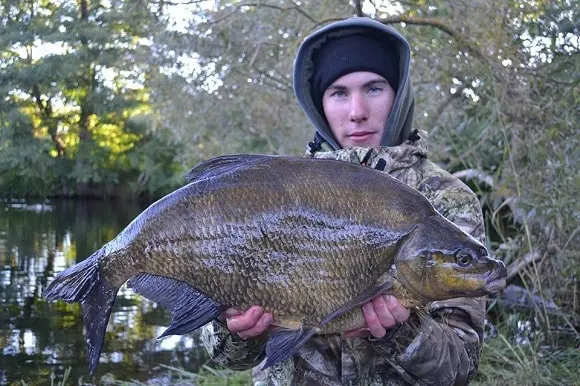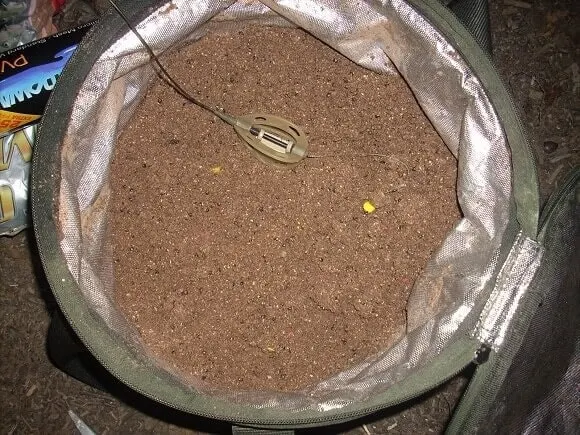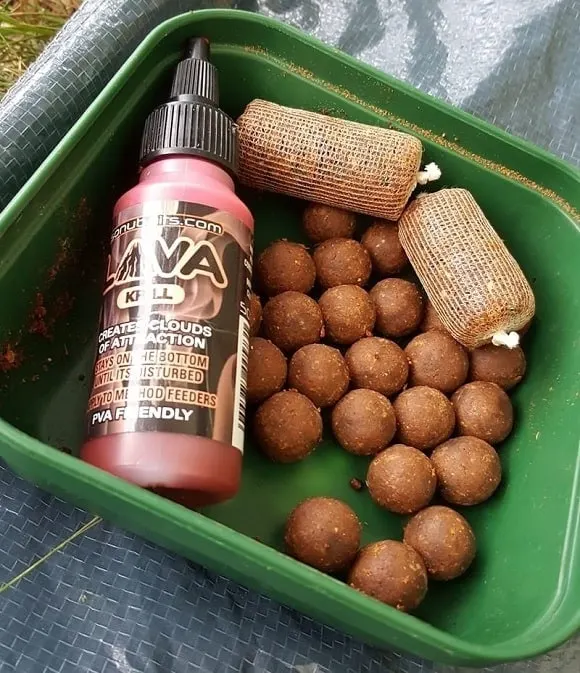The common bream is one of our most popular coarse fish and one that can be caught on a variety of baits. However, even if this species can eat copious amount of food and isn’t all that picky when it comes to hookbaits, I have found that using the right bait and presenting it the right way can make a lot of difference, especially when it comes to bigger bream.
So, in order to help you improve your bream fishing, I have decided to write this helpful guide on the best baits for common bream. In it, I’m not merely listing up the best bream baits, but I will also explain what end tackle you should be using, when to fish what bait, as well as the best respective fishing method for them.
Sweetcorn
The number one bait for bream can only be sweetcorn! This amazing hookbait works great for all kinds of coarse fish, and the bream is certainly one of them.
No matter if you put it in your groundbait, loosefeed it or use it on the hook, bream will find any swim that contains sweetcorn and eat up every grain until there is nothing left. They simply love corn!
It’s probably the hard-to-beat combination of the bright yellow colour, the size and the aroma of the sweetcorn that makes it such a superb bait. Personally, I have caught hundreds of fish on this little grain and you won’t find me on the bank without at least a couple of cans of corn!
When to Use Sweetcorn?
This is a bait that works best during late spring and early autumn when the water is a little colder and the fish aren’t as active and hungry yet. The sweet and strong aroma of the sweetcorn will nicely spread itself underwater, attracting even the slowest of bream into your swim.
How to Fish with Sweetcorn?
Sweetcorn can be fished both on the lift method, on a cage feeder rig, as well as on the method feeder. One or two grains on a #8-#12 hook will be perfect for bream fishing.
Maggots and Casters

Red and white maggots, as well as brown casters, are a real bream magnet and are perfect for both coarse and specimen fishing, as they’ll attract all sizes of bream.
Loosefeeding with larger quantities of maggots or casters especially can really activate your swim and keep the bream engaged and feeding for hours.
Of course, in venues with a larger number of small fish, neither maggots nor casters shouldn’t be your first choice, as they’ll usually also attract small roach, rudd, or bleak into the swim and onto your hook.
When to Use Maggots and Casters?
Maggots and casters can be used throughout the year, but in my experience, they work best during late autumn, winter and early spring, when the water is really cold and the fish need a lot of protein, which maggots provide.
How to Fish with Maggots and Casters?
Maggots work really well on both the lift method, a cage feeder rig or a maggot feeder rig. Put on a few squirmy white and red maggots on a #12-#14 wide gape hook and start catching those bream! The same goes for casters, but make sure to always use a slim shanked hook and cast out your rig with great care, as their shell is very delicate and can easily break.
Worms
Worms are another exquisite hookbait for bream. Both smaller and really big, fat worms have proven really effective baits for common bream. Especially bigger specimens seem to go for this type of bait and it must surely be the worm’s special earthy and juicy scent that makes it so irresistible to fish!
Pro Tip: You can’t really loosefeed with worms, but you can chop them up into smaller pieces and put them into your groundbait mix. It’ll be the best groundbait you’ve ever used and bream go absolutely nuts for it! Amazon has some really good multi-bladed worm scissors that you can find here.
When to Use Worms?
While smaller worms are another classic coldwater bait, the big, fat variety can be used very effectively during high summer, as well as for night fishing.
How to Fish with Worms?
Smaller worms work great on the lift method and can be presented on a size 10-12 hook. Bigger worms are better suited for feeder fishing on a size 8-10 hook, depending on their size and thickness. Leave a fair length of them dangling from the hook, as the bream like to slowly suck in the hookbait, like a spaghetti.
Cocktail Baits
Cocktail baits, meaning a combination of two or three different types of baits, have proven to be a deadly hookbait for bream. Cocktail variants should be tried out when the fishing with one bait is slow and the fish aren’t really willing to bite. The combination of different baits can on the other hand look very appealing and raise their interest, which then often leads to a bite.
Try out the following cocktail baits for bream (they have caught me a lot of fish over the years):
- Worm/sweetcorn
- Sweetcorn/maggot
- Sweetcorn/caster
Groundbait

When it comes to fishing for bream, groundbait should never be disregarded! Whether you are fishing with a float, cage or method feeder, always make sure to have enough groundbait in your swim. If and when a pack of bream enters the swim, they will immidiately start feeding, and usually, they are very hungry!
If there’s no more food left in the swim, they will move on quickly, and when that happens, it can be rather difficult to get them back.
Pro Tip: Read this in-depth article on the best groundbait and particles for bream fishing if you want to further improve your coarse fishing!
When to Use Groundbait?
Always! If you want to keep those fish interested and feeding, you’ll have to give them something to munch on. The art is not to overfeed them, so that they’ll still go for your hookbait.
Use only moderate amounts of groundbait in coldwater conditions, as the fish will generally feed less and hence get filled up much quicker. Less is more here, and frequent rebaiting of smaller amounts of groundbait is the ticket in cold water.
When the water is warm, you can literally not get out too much groundbait. They’ll eat up everything you through at them! Start with a few kilos to activate the swim and get the fish going. Then just keep feeding regular amounts after each and every bite.
How to Fish with Groundbait?
When float fishing, the best way to get your groundbait out to your swim is by forming smaller or larger balls and casting them close to your float. When ledgering, you simply put the groundbait into your cage or around your method feeder and cast out the bait together with your rig.
Now, we leave the natural baits behind us and take a closer look at some processed and artificial hookbaits for bream.
RELATED ARTICLE: Make sure to also read this article on the absolute best baits for tench fishing
Fake Corn
This is one of my all-time favorite hookbaits for specimen bream. Fake pop-up corn comes in different sizes and flavours and is a really effective bait for big bream.
In order to make them even more effective, you can dip and marinate them in a bait dip prior to your session. I like to use sweet or smelly flavours, such as pineapple, molasses or krill.
When to Use Fake Corn?
Fake corn should be used only during the warmer months of the year, as you generally fish this type of bait on the hair rig. Hence, it does not do well when the bream are slow and bite carefully. During late spring and summer though, it’s definitely one of the best artificial bream baits out there!
How to Fish with Fake Corn?
As mentioned, fake corn is best fished on the hair in combination with either a method feeder or conventional safety clip bolt rig. Use a one or two pop-up corn on a size 8 wide gape carp hook and make the hair very short, so that the first fake corn is almost touching the hook’s bend.
Also, make sure to critically balance your fake corn with a little piece of putty or a small split shot on the hair.
Pro Tip: Enterprise Tackle has, by far, the best pop-up fake corn on the market. I have used them for years and have had brilliant results with them. You can dip your fake corn in a sweet or smelly bait dip, like caramel or krill, to make them even more delicious. Check out Enterprise Tackle’s fake corn on Amazon here.
Boilies

Smaller boilies are another really great bait for specimen bream. They manage to catch bigger fish because their size often keeps away smaller-sized fish, which can be very advantageous if you are targeting larger bream. I have found that 8-12mm boilies have the perfect size for bigger bream.
I prefer boilie flavours that are either sweet, spicy or fishy for my bream fishing. The following three flavours have produced a lot of fish for me over the years:
- Dynamite Bait’s The Source
- Mainline’s Pineapple
- Sticky Baits Krill
When to Use Boilies?
Boilies are classic warm water baits for common bream. They’re packed with nutrients and hence have to be fished when the bream are hungry and willing to feed a lot.
How to Fish with Boilies?
Like fake corn, boilies should be fished on the hair, together with a bigger method feeder or a common safety clip bolt rig.
I keep my hook length fairly short, as bream do not move much while picking up the bait. A short hook length of about 3-4 inches will improve the bolt effect of your rig significantly.
Use a size 6 hook for 12mm and a size 8 hook for 8mm boilies and keep the hair rather short.
Pro Tip: If you scale down your boilie a little, meaning using your scissors or a knife to cut off the edges, thereby making it smaller, you can also top it with a fake corn, apropos great cocktail baits.
Pop-Ups
Much like boilies, pop-ups can work really well for bigger bream. Their biggest advantage is their visibility, as you can fish them a little off the bottom, which can make a lot of difference on slow days.
The visibility aspect is also the reason why I always choose brightly coloured pop-ups for bream. They can be spotted so much easier and really stick out in your swim, especially in deeper or darker water.
Pro Tip: My go-to pop-up is a 12mm Sticky Bait Manilla, a wonderfully sweet and attractively flavoured white pop-up that will land you a lot of fish! You can take a closer look at the awesome Sticky Baits Manilla Pop-Up on Amazon here.
When to Use Pop-Ups?
Bigger pop-ups should, much like boilies, only be used in warmer water conditions, when the fish are fairly hungry and active.
However, smaller-sized pop-ups can work really well in colder water as well. I have had great success fishing mini pop-ups in the middle of winter and in early spring.
How to Fish with Pop-Ups?
For pop-ups, you should apply the same setup as for boilies, meaning method feeder or bolt rigs, short hook lengths of about 3-4 inches, a size 6 wide gape carp hook for 10-12mm pop-ups and a size 8 hook for 6-8mm mini pop-ups, a short hair, and a little putty or a split shot to critically balance the hookbait. It should float a mere 1-2cm above the bottom.
Pellets
Pellets are a really awesome and versatile bait for bream that can be used for both loosefeeding, upgrading your groundbait or directly on the hook.
I have found that bream who generally don’t respond well to other baits can often bite fairly well on pellets, as they blend in with the rest of the free offerings in your swim.
When to Use Pellets?
Pellets are a rather rich food source and should hence be fished only during the warmer months of the year. They work really great from late spring, thorughout summer and into early autumn, before the water starts to cool down.
How to Fish with Pellets?
Pellets are best fished o the hair rig or directly on your hook shank via a bait band. I find 6-8mm pellets to be the perfect size if you are using them as hookbaits. Fish them on a size 8-10 wide gape specimen hook and use very tight bait bands, as they tend to slip out easily when casting out your rig.
Pro Tip: Sticky Baits has a whole range of really awesome feed pellets for bream. I especially like their bloodworm and krill pellets, which can work wonders for big bream especially. Check out their high-quality pellets on Amazon here.

